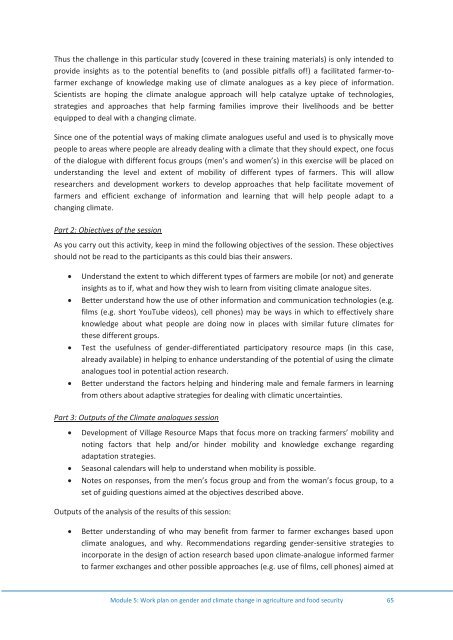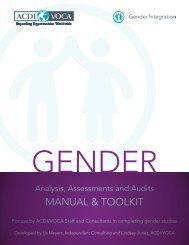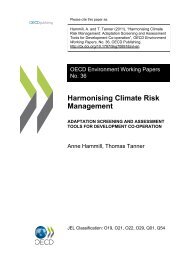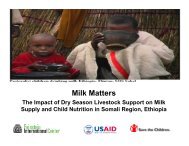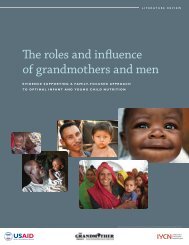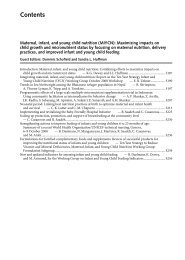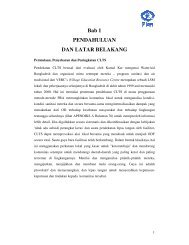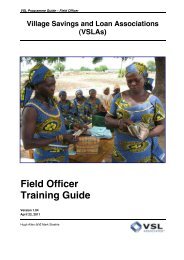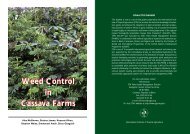Gender and climate change research in - FAO
Gender and climate change research in - FAO
Gender and climate change research in - FAO
Create successful ePaper yourself
Turn your PDF publications into a flip-book with our unique Google optimized e-Paper software.
Thus the challenge <strong>in</strong> this particular study (covered <strong>in</strong> these tra<strong>in</strong><strong>in</strong>g materials) is only <strong>in</strong>tended to<br />
provide <strong>in</strong>sights as to the potential benefits to (<strong>and</strong> possible pitfalls of!) a facilitated farmer-tofarmer<br />
ex<strong>change</strong> of knowledge mak<strong>in</strong>g use of <strong>climate</strong> analogues as a key piece of <strong>in</strong>formation.<br />
Scientists are hop<strong>in</strong>g the <strong>climate</strong> analogue approach will help catalyze uptake of technologies,<br />
strategies <strong>and</strong> approaches that help farm<strong>in</strong>g families improve their livelihoods <strong>and</strong> be better<br />
equipped to deal with a chang<strong>in</strong>g <strong>climate</strong>.<br />
S<strong>in</strong>ce one of the potential ways of mak<strong>in</strong>g <strong>climate</strong> analogues useful <strong>and</strong> used is to physically move<br />
people to areas where people are already deal<strong>in</strong>g with a <strong>climate</strong> that they should expect, one focus<br />
of the dialogue with different focus groups (men’s <strong>and</strong> women’s) <strong>in</strong> this exercise will be placed on<br />
underst<strong>and</strong><strong>in</strong>g the level <strong>and</strong> extent of mobility of different types of farmers. This will allow<br />
<strong>research</strong>ers <strong>and</strong> development workers to develop approaches that help facilitate movement of<br />
farmers <strong>and</strong> efficient ex<strong>change</strong> of <strong>in</strong>formation <strong>and</strong> learn<strong>in</strong>g that will help people adapt to a<br />
chang<strong>in</strong>g <strong>climate</strong>.<br />
Part 2: Objectives of the session<br />
As you carry out this activity, keep <strong>in</strong> m<strong>in</strong>d the follow<strong>in</strong>g objectives of the session. These objectives<br />
should not be read to the participants as this could bias their answers.<br />
<br />
<br />
<br />
<br />
Underst<strong>and</strong> the extent to which different types of farmers are mobile (or not) <strong>and</strong> generate<br />
<strong>in</strong>sights as to if, what <strong>and</strong> how they wish to learn from visit<strong>in</strong>g <strong>climate</strong> analogue sites.<br />
Better underst<strong>and</strong> how the use of other <strong>in</strong>formation <strong>and</strong> communication technologies (e.g.<br />
films (e.g. short YouTube videos), cell phones) may be ways <strong>in</strong> which to effectively share<br />
knowledge about what people are do<strong>in</strong>g now <strong>in</strong> places with similar future <strong>climate</strong>s for<br />
these different groups.<br />
Test the usefulness of gender-differentiated participatory resource maps (<strong>in</strong> this case,<br />
already available) <strong>in</strong> help<strong>in</strong>g to enhance underst<strong>and</strong><strong>in</strong>g of the potential of us<strong>in</strong>g the <strong>climate</strong><br />
analogues tool <strong>in</strong> potential action <strong>research</strong>.<br />
Better underst<strong>and</strong> the factors help<strong>in</strong>g <strong>and</strong> h<strong>in</strong>der<strong>in</strong>g male <strong>and</strong> female farmers <strong>in</strong> learn<strong>in</strong>g<br />
from others about adaptive strategies for deal<strong>in</strong>g with climatic uncerta<strong>in</strong>ties.<br />
Part 3: Outputs of the Climate analogues session<br />
<br />
<br />
<br />
Development of Village Resource Maps that focus more on track<strong>in</strong>g farmers’ mobility <strong>and</strong><br />
not<strong>in</strong>g factors that help <strong>and</strong>/or h<strong>in</strong>der mobility <strong>and</strong> knowledge ex<strong>change</strong> regard<strong>in</strong>g<br />
adaptation strategies.<br />
Seasonal calendars will help to underst<strong>and</strong> when mobility is possible.<br />
Notes on responses, from the men’s focus group <strong>and</strong> from the woman’s focus group, to a<br />
set of guid<strong>in</strong>g questions aimed at the objectives described above.<br />
Outputs of the analysis of the results of this session:<br />
<br />
Better underst<strong>and</strong><strong>in</strong>g of who may benefit from farmer to farmer ex<strong>change</strong>s based upon<br />
<strong>climate</strong> analogues, <strong>and</strong> why. Recommendations regard<strong>in</strong>g gender-sensitive strategies to<br />
<strong>in</strong>corporate <strong>in</strong> the design of action <strong>research</strong> based upon <strong>climate</strong>-analogue <strong>in</strong>formed farmer<br />
to farmer ex<strong>change</strong>s <strong>and</strong> other possible approaches (e.g. use of films, cell phones) aimed at<br />
Module 5: Work plan on gender <strong>and</strong> <strong>climate</strong> <strong>change</strong> <strong>in</strong> agriculture <strong>and</strong> food security 65


